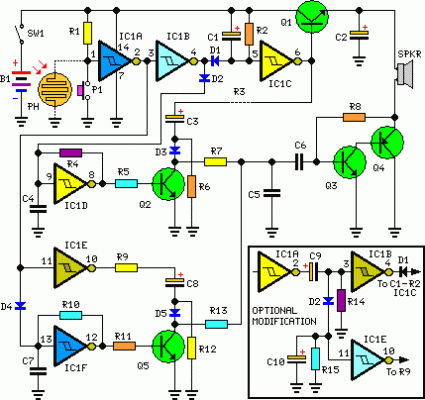FREE
circuits!
How to build Bells Ring Generator Circuit Schematic
October 1, 2010 - category: Sound generatorDescription
This circuit generates a dual-tone bells ringing similar to most door-bell units. It can be used in many applications other than door-bell. In the Notes below several options will be given in order to suit different needs. The circuit as shown in the diagram generates a "Ding-tone" when P1 is pressed and a "Dong-tone" when P1 is released. IC1D is the first-tone frequency generator and IC1F generates the second-tone.
Q2, Q5 and related components act as shape and decay controls of the two tones, trying to imitate as close as possible the bells sound. Their outputs are mixed (R7 & R13), filtered (C5) and boosted by a simple class-A audio amplifier (Q3 & Q4) in order to drive the loudspeaker. The amplifier is switched-on by Q1 when P1 is pressed, then is switched-off some seconds after P1 is released: this time-delay is fixed by C1 & R2. In this way the circuit will draw a negligible current when in stand-by mode.
Circuit diagram:
Parts:
- R1,R3,R7,R9,R13_10K 1/4W Resistors
- R2_______________1M5 1/4W Resistor
- R4______________27K 1/4W Resistor
- R5,R11__________47K 1/4W Resistors
- R6,R12_________220K 1/4W Resistors
- R8_______________2M2 1/4W Resistor
- R10_____________33K 1/4W Resistor
- C1_______________2µ2 25V Electrolytic Capacitor
- C2______________47µF 25V Electrolytic Capacitor
- C3,C8___________10µF 25V Electrolytic Capacitors
- C4,C7___________10nF 63V Polyester Capacitors
- C5,C6__________100nF 63V Polyester Capacitors
- C9_______________4µ7 25V Electrolytic Capacitor
- C10______________1µF 25V Electrolytic Capacitor
- D1-D5_________1N4148 75V 150mA Diodes
- IC1__________MC14106 or 40106 Hex Schmitt Inverter IC
- Q1_____________BC337 45V 800mA NPN Transistor
- Q2,Q3,Q5_______BC238 25V 100mA NPN Transistors
- Q4 ____________BC327 45V 800mA PNP Transistor
- PH______________Photo resistor (any type) (see Notes)
- P1______________SPST Pushbutton (see Notes)
- SW1_____________SPST Switch
- SPKR____________8 Ohm Loudspeaker
- B1______________3V Battery (two 1.5V AA or AAA cells in series etc.)
- Parts added to optional modification:
- R14____________220K 1/4W Resistor
- R15______________1M 1/4W Resistor
Notes:
- To obtain a "Ding-Dong" operation when pushing on P1, no matter when it is released, you must modify the circuit as shown in the frame placed at the low-right corner of the circuit diagram. D4 must be removed. C10 & R15 set the time-delay separating first and second tone.
- To obtain a one-tone-only generator, wire the circuit as in the optional modification, making the following changes:
- C9 = 100nF 63V Polyester Capacitor.
- Omit R9 to R13 & R15; C7, C8 & C10; D2, D4, D5 & Q5.
- Connect to negative supply pins 11 & 13 of IC1 and left open pins 10 & 12.
- An amusing application of this circuit wired as in the original schematic, is to use a photo-resistor in place of P1, then placing the unit near the flashing lamps of your Christmas tree. A soft bell sound may be heard at switch-on and switch-off of the lamp chosen.
- To obtain higher output power you may substitute R8, Q3 & Q4 with an audio amplifier IC like the LM386 or LM380. In this case power supply must be raised to 6 - 12V but at the same time R4 & R10 should be changed to adjust bell-tone frequencies.
- Good tone frequencies are roughly 2000 and 1650Hz respectively.
- When in stand-by mode, current drawing of the circuit is 200µA @ 3V supply: therefore SW1 can be omitted.
circuit from http://www.extremecircuits.net/2010/01/bells-ring-generator-circuit-schematic.html



 This category
This category